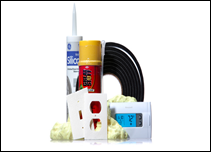Letting Your House Breathe — But Not Too Much
by Bob Tedeschi, NEW YORK TIMES, January 12, 2011
 LITTLE known fact: your house breathes.
LITTLE known fact: your house breathes.
A typical home is supposed to exhale about 33 percent of its air every hour, sparing your lungs from mold, dust and other tiny invaders.
My house doesn’t breathe. It hyperventilates. Every hour it purges about 75 percent of its air — which is fine for my family’s health, but it kills me to think that we pay to heat that air and then quickly set it free.
I’ll explain the source of that 75 percent figure a little later. Right now let’s focus on the basic mission: finding where the air is escaping, plugging those holes and watching the heating bill shrink.
Job No. 1 — locating the leaks — was a challenge. My home has foam insulation, fiberglass insulation, insulated windows, weatherstripping and enough caulk to seal a ship. How exactly does 75 percent of my air escape every hour?
I posed the question to three residential energy specialists, and in the process learned some tricks — a few of which will also help apartment dwellers, who usually have no worries about foundation cracks or attic insulation.
My panel included Kelly Parker, a board member of the Residential Energy Services Network, an association of firms that rate home energy efficiency; Michael David, lead technician for New England Conservation Services, which performs energy audits and upgrades; and Bob Gfeller, a senior vice president at Lowe’s.
Finding a leak is easy, they said. Get a blower door, which depressurizes a house so that even the tiniest drafts blow like a stiff wind. They cost a mere $2,900. Second choice: a Black & Decker laser thermal leak detector ($42, at Lowe’s), which will identify the cold spots that coincide with leaks.
The most cost-effective sleuthing device, though, is even cheaper and may already be in your home — a stick of incense. Pick a breezy day and pass the burning stick near any seam in your house, and the smoke will reveal where the leak is.
I took a lighted incense stick around my doors and windows, and the technique worked fairly well, even if I grew completely sick of the smell after a while.
But Mr. David and his colleagues later found that I’d missed some spots I hadn’t even thought to check, like the seam between my fireplace and the wall, and my baseboard heaters. My two biggest omissions were the attic and the basement.
“If your attic access is inside the house, that’s a big one to watch for,” Mr. Parker said. “If it’s not well sealed, it’s like leaving a big door open.”
At some point in the last few years, I lost a bolt that secured one of the two big springs in my drop-down attic ladder, leaving one corner sagging about a half-inch from the ceiling. I never considered the effect that sag might have on my budget until I envisioned air streaming through the gap.
As for the basement, “Check the places where all your piping is coming and going,” Mr. Gfeller said. “Sometimes things happen, like your house might settle, and it’ll open a pretty good-sized crack.”
To spot those leaks, try this: Go to the basement in the daytime, but keep the lights turned off. Depending on the angle of the sun, you may detect cracks from the daylight shining through the foundation.
For me, this exercise actually solved two mysteries. The pipes to my outside water spigots apparently travel through holes big enough to accommodate much airflow — and many mice. (Stay tuned for a column on rodent removal.)
Basement doors are another area of vulnerability, since people often pay little attention to how well they’re constructed or maintained. In my case, the frame was surrounded with gaps that had probably been there the entire decade we’ve lived in the house.
If you have a fireplace, don’t even bother checking it.
“They all leak,” Mr. David said. “Even if you have the flue closed.”
Doesn’t my fancy hearth cover help?
“Nope,” he said. “Those all leak, too.”
Last, a word to those with central air or central heat: try the incense trick around the seams of the ductwork. Even a small gap can allow costly leaks. [Read rest of article]


